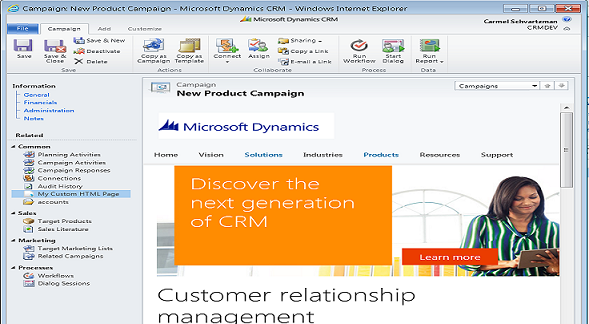- In this article we see how to programmatically create a CustomerAddress in Dynamics CRM 2011/2013.
In CRM 2013, the address data of an Account or a Contact are stored in a separate Entity called CustomerAddress, on a 1:N relationship basis, in which an Account can have (and have, by default) many addresses.
This post is about Dynamics CRM 2011 - 2013 custom Plugins or custom Workflows, and any C# code which calls the CRM Organization Web Service to create a new CustomerAddress item , that means, a third address for an Account or a Contact. The following snapshot shows the Account address fields:
How to programmatically create a CustomerAddress in Dynamics CRM 2011/2013
- When an Account is created, CRM creates by default 2 addresses for it, from the CustomerAddress entity type, which are called Address1 and Address2.
- If you intend to programmatically update the Account or Contact address, and not to create a new address, you just instantiate the following Account fields with the data, and CRM will automatically update the corresponding CustomerAddresses objects related to the specific Account:
oAccount["address1_telephone1"]
oAccount["address1_line1"]oAccount["address1_city"]oAccount["address1_postalcode"]
Change "Address1" with "Address2" if you want to update the second Account address.
If you intend to create a new (third) CustomerAddress item for the Account, follow this step by step instructions:
- First we write a check to see whether we got a legal ID of the Account we want to refer to:
if (guidParentAccount.HasValue){
- Then we create the CustomerAddress entity , and instantiate the "ParentID" of the CustomerAddress . When creating a new address for an Account or a Contact entity, it's crucial to provide a reference field which points to the "ParentId" , that means , the Account or Contact to which belongs this new address. The C# code below instantiates the "ParentId" property with the actual Account , and not just the Parent's ID (guid) :
Entity oAccountAddress = new Entity("customeraddress");
EntityReference parentID = new EntityReference();
parentID.Id = guidParentAccount.Value;
parentID.LogicalName = "account";
oAccountAddress.Attributes["parentid"] = parentID; - However, if you try to instantiate this "ParentId" field with the guid, you will be confronted with an exception , that's raised informing that the value is null : this error message is misleading, and we wrote about it in another article here.
- Another way, shorter, to instantiate the ParentID is the following:
oAccountAddress["parentid"] = new EntityReference("account", guidParentAccount.Value ); - Next we save the street in the "line1" field: for the example, here i made a street search by street code on a generic List<> which contains street codes and descriptions:
string sStreetDescription = String.Empty;
if ( oStreetList != null && oStreetList.Count > 0 && iStreetCode > 0)
{
sStreetDescription = oStreetList.FirstOrDefault(sc => sc.Code == iStreetCode).Description;
if (sStreetDescription.Length > 0)
{
oAccountAddress["line1"] = sStreetDescription;
}
} - Next we save the city in the "city" field: for this example, here i got a city object also from data migration, which contains both city code and description:
string sCityDescription = String.Empty;
if (oCity != null)
{
sCityDescription = oCity.Description;
if (sCityDescription.Length > 0)
{
oAccountAddress["city"] = sCityDescription;
}
} - Then we instantiate the "postalcode" and "telephone1" properties:
if (oAccount.Zip != null)
{
oAccountAddress["postalcode"] = Convert.ToString(oAccount.Zip);
}
oAccountAddress["telephone1"] = oAccount.Phone ?? "0"; - Finally we call the Organization Web Service to create the CustomerAddress entity from the Account:
Guid? guidAccountAddress = XrmContext.Create(oAccountAddress); - The CRM database will then reflect the 3 addresses (AddressNumber 1,2 and 3) as shown here:

That's all...Enjoy Dynamics CRM!!!
by Carmel Schvartzman
כתב: כרמל שוורצמן

Hello is there a way how to make newly inserted address primary address for account if it has already one ?
ReplyDelete